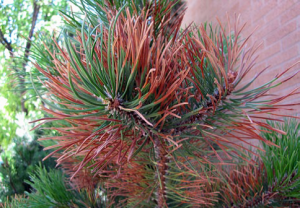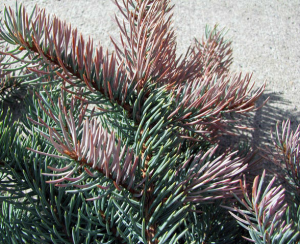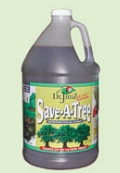Winter Damage on Evergreens
Winter Damage on Evergreens
Although the eastern half of the country experienced one of the hardest winters in years, here in east Idaho our winter seemed fairly mild. So why are we seeing browning of needles on so many of the evergreens around town? It has to do with the precipitous drop in temperatures back in early December of last year. In mid November we experienced highs in the 60’s, but by December 3rd it dropped below zero with daily lows below zero for 11 straight days, the coldest (in Idaho Falls) being -19F on December 9. Getting that cold that quickly is tough on plants, and is likely the reason that we are seeing the winter damage that we are seeing.
This is what Utah State University Extension had to say about it in their Weekly Pest Update for Woody Ornamentals dated today. I thought it was worth repeating here, just substitute “Idaho” everywhere they say “Utah”.
While the eastern U.S. was suffering through the polar vortex, Utah’s winter was pretty mild. In early December, however, there was a sharp drop in temperatures from warm conditions to the high negative digits over a 24-hour period. This event resulted in bud kill, dieback, and dessication on some trees.
 Trees that are somewhat more tender or not entirely adapted to the zone in which it was planted will have some bud kill or death of smaller twigs. To determine if buds are alive or dead, remove a random sample and slice them in half. Dead buds will be almost hollow or completely brown inside. By now, live buds have started to plump up and expand, and will be easier to detect. Flower buds are usually less hardy than leaf buds, so if you notice fewer flowers on ornamental trees and shrubs, the reason may be winter kill.
Trees that are somewhat more tender or not entirely adapted to the zone in which it was planted will have some bud kill or death of smaller twigs. To determine if buds are alive or dead, remove a random sample and slice them in half. Dead buds will be almost hollow or completely brown inside. By now, live buds have started to plump up and expand, and will be easier to detect. Flower buds are usually less hardy than leaf buds, so if you notice fewer flowers on ornamental trees and shrubs, the reason may be winter kill.
 Across much of Utah, many evergreens are showing brown leaves and needles. This type of injury is due to dessication, partly from the cold temperatures in December, and partly from the lack of snow cover in January. Evergreen plants transpire throughout the winter months, particularly on windy or sunny days. However, once the soil freezes, the plant’s roots are no longer able to absorb moisture and cannot replace the moisture lost from the leaves or needles. While the injury occurs during the winter months, foliage don’t start browning up until late winter or early spring. Damage is most often located on the south and west sides of evergreens. Trees that are especially injured may have experienced drought conditions last summer. Plants with dessication injury still have viable buds. The brown foliage will eventually drop and when live buds emerge, the new growth will “cover” the injured areas. Evergreens that have sustained light to moderate damage will look much better by late spring.
Across much of Utah, many evergreens are showing brown leaves and needles. This type of injury is due to dessication, partly from the cold temperatures in December, and partly from the lack of snow cover in January. Evergreen plants transpire throughout the winter months, particularly on windy or sunny days. However, once the soil freezes, the plant’s roots are no longer able to absorb moisture and cannot replace the moisture lost from the leaves or needles. While the injury occurs during the winter months, foliage don’t start browning up until late winter or early spring. Damage is most often located on the south and west sides of evergreens. Trees that are especially injured may have experienced drought conditions last summer. Plants with dessication injury still have viable buds. The brown foliage will eventually drop and when live buds emerge, the new growth will “cover” the injured areas. Evergreens that have sustained light to moderate damage will look much better by late spring.
What to do Now and This Summer
If you suspect dieback on hardwoods or see needle burn on conifers, you can help trees along this season. Apply a light application of fertilizer now and water the trees during the dry months to encourage new growth and speed recovery. Any parts of the plant that are still completely brown or bare of leaves or needles by early June are dead, and should be pruned out.

I recommend feeding either with Save-A-Tree (liquid) or T&C Tree & Shrub Food (granule) right now. Water the trees well, then wait and see. You can prune the brown and dead out in late spring or early summer when you will better know which branches are actually dead.


